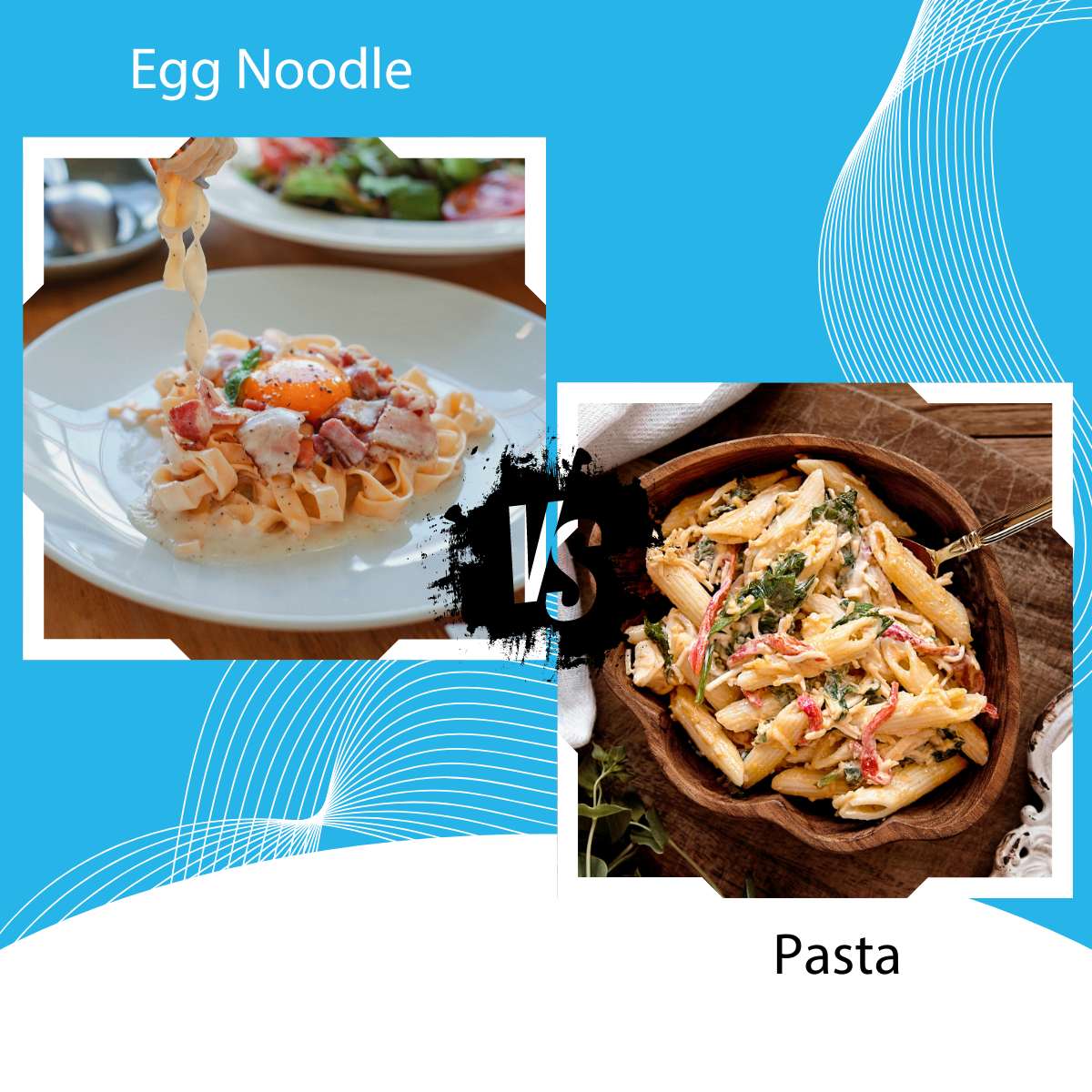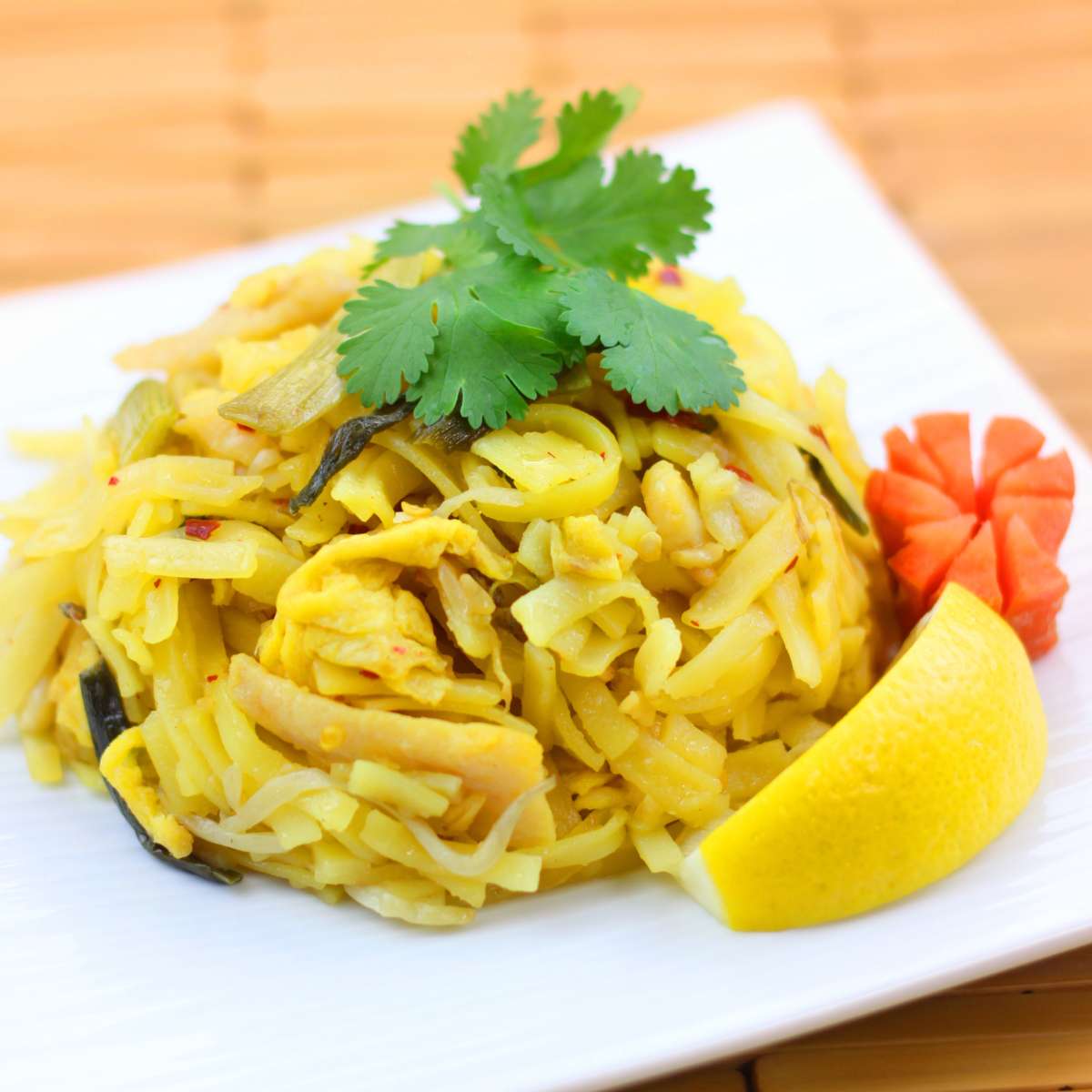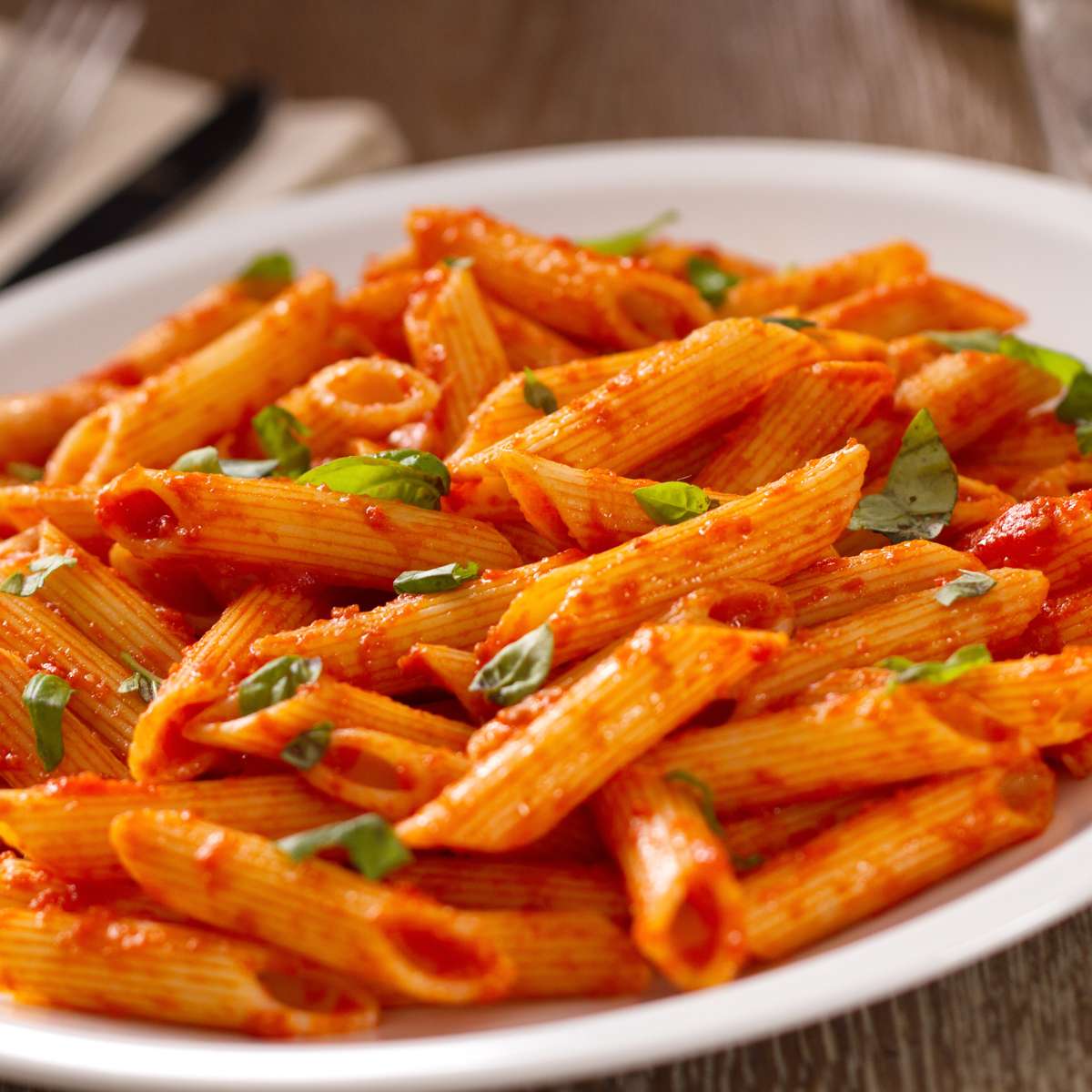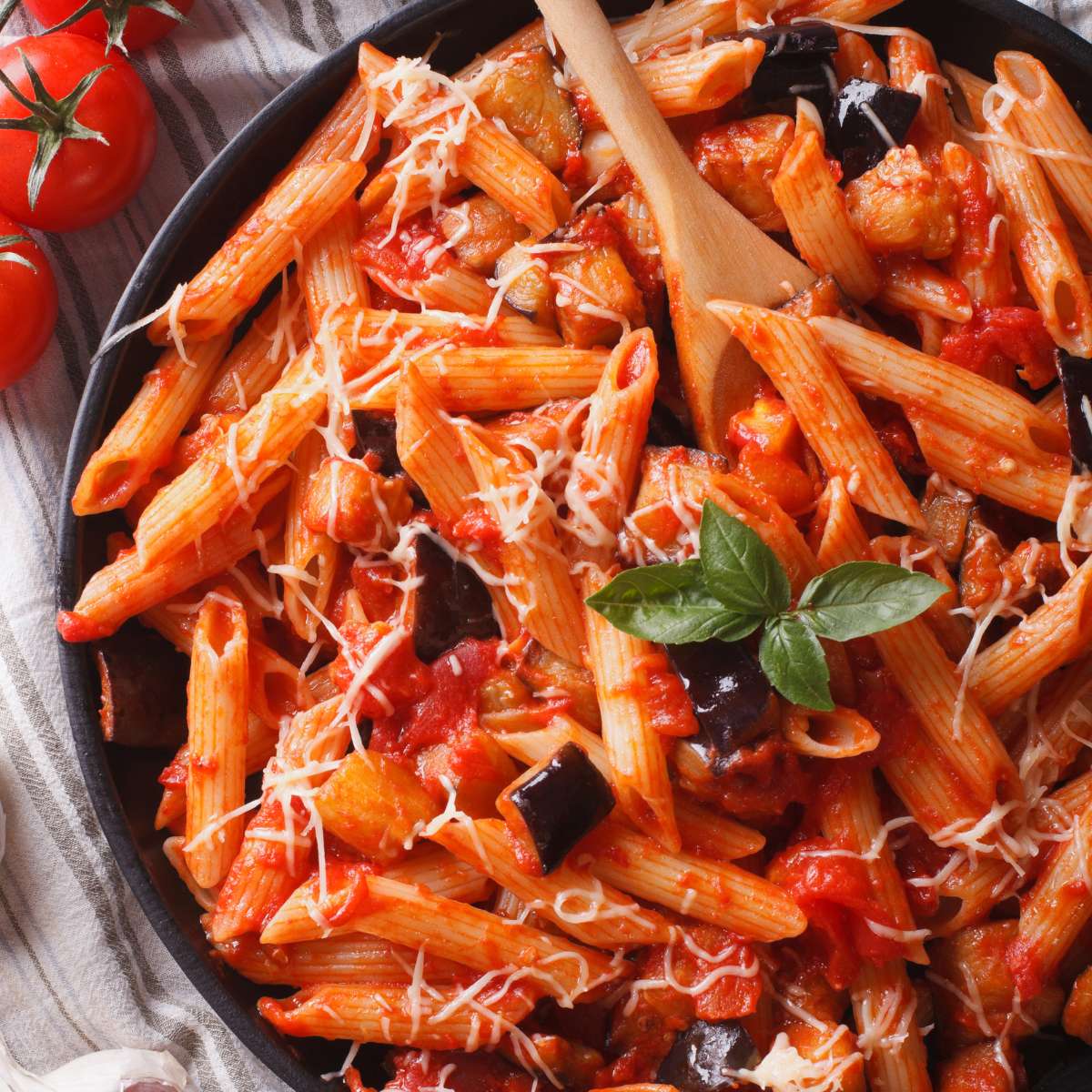Hey there, fellow foodie! Ready to unravel the delicious enigma wrapped in flour and egg? When you’re stuck in the grocery aisle, pondering the difference between egg noodle and pasta, know that you’re not alone.
It’s the culinary showdown we’ve all faced—egg noodle vs pasta: which will be the champion of your next meal? Let’s break down these carb contenders and see if we can’t find you some scrumptious egg noodle recipes to spice up your dinner game.
Whether tossed in a savory broth or cloaked in a hearty sauce, these two staples of comfort food come from a lineage as rich and complex as their flavors. Take a seat and join us on this flavorful adventure that promises no forks left unturned.
Egg noodles, with their eggy canvas, paint a vibrant, yellow-rich road to a satisfying bite, while pasta, in its ever-fashionable Italian shoes, walks the line between delicate and robust. Oh, and if you’re licking your lips in anticipation, just wait until we get to those lip-smacking recipes!
Key Takeaways
- Discover the fundamental difference between egg noodle and pasta in terms of ingredients and taste.
- Uncover the secret behind that golden hue and rich flavor unique to egg noodles.
- Explore the vast world of pasta and learn why its diverse shapes could be your new best friend in the kitchen.
- Find out which of these versatile options takes the crown for easing your weekly dinner dilemma.
- Arm yourself with a treasure trove of egg noodle recipes for cozy nights in.
- Embrace the palatable pleasures and subtle differences that have positioned both as beloved classics on tables worldwide.
Unwrapping the History of Egg Noodles and Pasta
Let’s take a stroll down memory lane, or should we say, the pasta aisle of history. Your culinary predecessors were not much different from you, relishing in the comfort of noodles and pasta. But where did it all start? Buckle up, because you’re about to embark on a time-traveling delight to uncover the origins of egg noodles and the history of pasta.
The Ancient Origins of Egg Noodles
If you thought egg noodles were the new kid on the block, think again. These supple strands have tales older than some countries, with a saga that begins in China. Archaeologists digging in Qinghai didn’t expect to find a culinary artifact but uncovered a 4,000-year-old bowl of noodles that could give any modern recipe a run for its money.
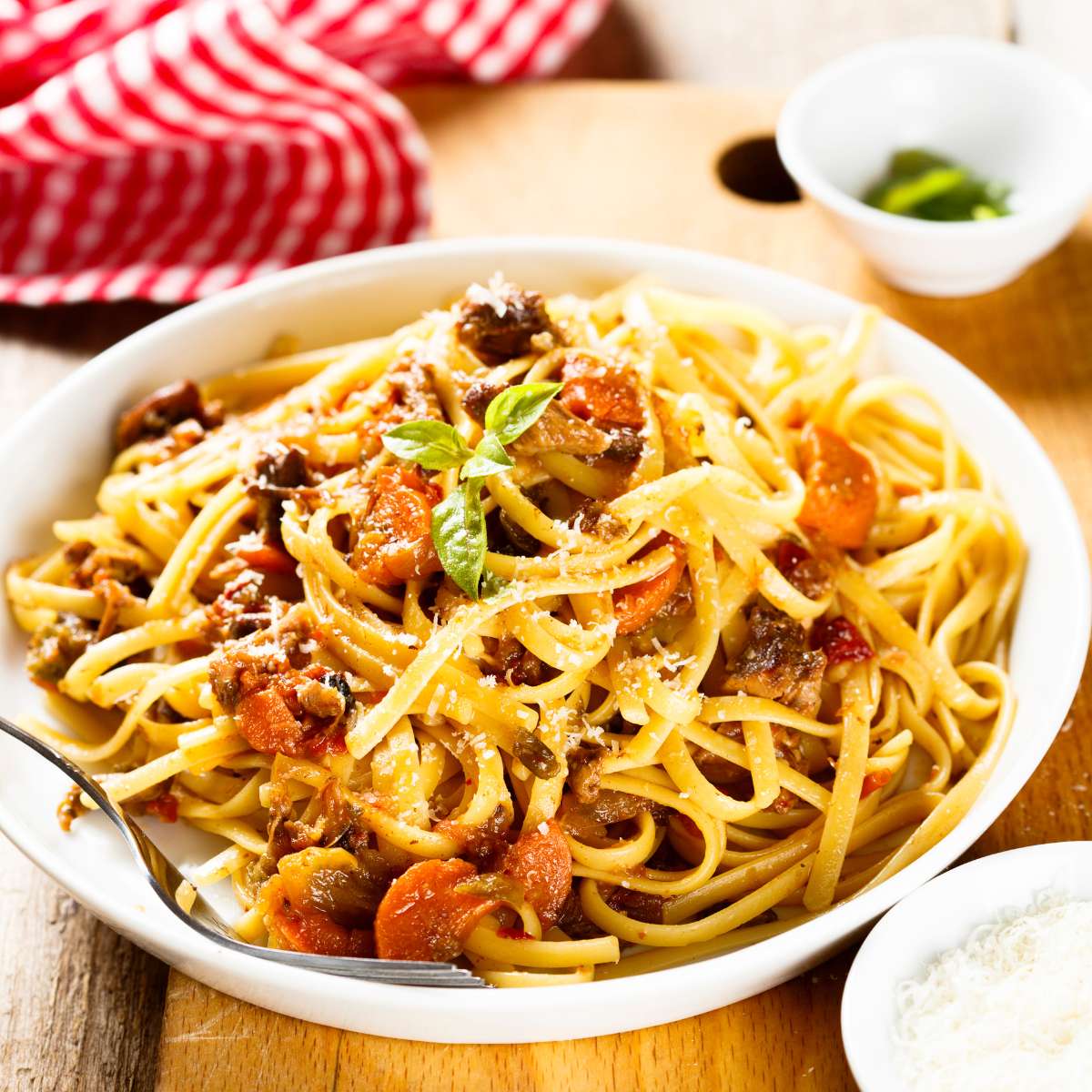
This evidence points to the fact that the origins of egg noodles are deeply rooted in ancient Asian cuisine, making your noodle soup a dish with millennia of heritage.
Pasta’s Debatable Beginnings
On the flip side, the history of pasta is like a game of historical tug-of-war. The Greeks, the Arabs, the Italians—who really called dibs on this culinary mainstay? While the jury’s still out, we do know that references to pasta-like dishes pop up across ancient civilizations, proving that this staple has been feeding the masses from Greece to Palestine since the third century.
Regardless of who claims the fame, one thing’s for sure: pasta’s diversity and adaptability have carved its place in the annals of food history quicker than you can say “al dente.”
| Era | Egg Noodles | Pasta |
|---|---|---|
| Ancient China | Documented in 25-200 AD | – |
| Ancient Greece | – | Early mentions of pasta-like dishes |
| Ancient Middle East | – | Ancestral pasta recipes in literature |
| Medieval Italy | – | Expansion of types of pasta |
No matter which origin story tickles your fancy, one thing is crystal clear: from the simple, comforting bowl of egg noodles to the artistry of pasta creations, you’re participating in a time-honored tradition every time you twirl that fork.
Egg Noodle vs Pasta: Diving Into Ingredients
Let’s roll up our sleeves and plunge into the culinary world of noodles and pasta—more specifically, the egg noodle ingredients versus the pasta dough components. If you’ve ever wondered why that forkful of fettuccine feels different from a spoonful of spaetzle, the answer is unassumingly resting in their elements.
And you, my friend, are about to become an ingredient connoisseur.
Imagine the dough of egg noodles like a cozy blanket, made of wheat flour cuddled up with eggs, and sometimes even a sprinkle of starches like arrowroot or tapioca for that extra snug texture.
Now picture pasta—think of it as an free-form artist’s canvas, primarily requiring only wheat or buckwheat semolina flour and water. Here, eggs and veggies are like optional splashes of paint, adding richness and flavor when invited to the party.
These subtle variances in mix-ins do more than just influence the symphony of flavors and the ballet of textures; they also waltz directly into the realm of pasta health benefits. With egg noodles twirling in with a bit more protein and a kiss of fat, pasta counters with its chameleon-like ability to synthesize regional and global tastes in its many forms.
| Egg Noodle Ingredients | Pasta Dough Components | Health Impact |
|---|---|---|
| Wheat Flour | Semolina Flour | Carbohydrate Source |
| Eggs | Water | Protein (Egg Noodles) |
| Optional Starch (e.g., Arrowroot) | Optional Eggs/Vegetables | Texture & Flavor Variance |
Be sure not to let the simplicity of these recipes fool you; the smallest switch in these kitchen staples can transform your dish from an everyday plate to a globe-trotting treat. And isn’t that the beauty of cooking?
Next time you find yourself in the aisles of your local grocery store, contemplating which package to take home, remember the journey you’ve taken today through the delightful simplicity of egg noodle and pasta ingredients.
Whether you’re craving the rich embrace of a protein-laden egg noodle dish or longing for that perfectly adaptable plate of pasta, you’ve got the knowledge you need to make your dish a sublime one.
Comparing the Textures: From Silk to Al Dente
Prepare your palate for a tactile tour through the world of noodles and pasta. You’ll find that the devil really is in the details—or in this case, the textures. From the spring in the forkful of egg noodle texture to the definitive ‘bite’ of perfect pasta consistency, it’s all about that mouthfeel that sends your taste buds to seventh heaven.
What Gives Egg Noodles Their Distinctive Texture
It’s no secret; the traditional egg noodle wouldn’t be what it is without its smooth and comforting texture. Imagine wrapping yourself up in a blanket just out of the dryer—that’s the kind of silken hug your tongue gets with every bite into an egg noodle.
Dive into a bowl, and you’ll be doing the backstroke through waves of tender, springy goodness that owe it all to a rich combination of eggs and premium flour.
The Art of Achieving Perfect Pasta Texture
Meanwhile, navigating the seas of pasta takes a keen sense of timing and respect for tradition. Whether it’s a firm spaghetti playing it coy against your teeth or the embrace of a perfectly cooked penne, striking that ‘al dente’ note isn’t just cooking—it’s a culinary symphony.
Precision is the maestro’s baton here, guiding you to that quintessential chew, making every dish sing with texture.
So, whether you fall in the camp of luxurious egg noodle enthusiasts or champions of iconic spaghetti, remember: texture tells a story, your story. Choose your texture wisely and write a delicious narrative with each meal.
Anatomizing Shapes and Sizes: Noodles vs Pasta Varieties
Let’s take a delightful little journey into the world of types of egg noodles and types of pasta. You’ll soon notice, dear reader, that the vast panoramic scene of pasta rivals mother nature in diversity. Where egg noodles are like the straight paths in your garden, pastas are the wildflowers breaking the pattern with their whimsical shapes and sizes.
Imagine this: a cozy German kitchen smelling of marjoram and thyme, where the broad, flat strips of egg noodles reign supreme in their doughy glory.
Meanwhile, Asian broths wink at you with their slender egg noodle threads bobbing along like festive streamers. Though the types of egg noodles keep to a few homely shapes, they’ve nestled themselves comfortably in dishes around the world.
Now envision the pasta landscape – an architect’s daydream. Thin, angelic strands of angel hair pasta compete with the robust, hollow bastions that are rigatoni. It’s not just about looking pretty on your plate; these shapes dictate how your sauce envelops each bite, how every forkful feels against your expectant palate.
Like little culinary chameleons, these different types of pasta absorb every hint of flavor, transforming each meal into a new adventure.
In a refrain of starchy harmonics, you can’t help but notice the similarities between egg noodle and pasta. They both start as humble dough, eager to take on whichever shape the heart desires, each bringing its own melody to the symphony that is your dinner.
- For the hearty: broad egg noodles swimming in stews.
- For the delicate: fine fettuccine twirling in light sauces.
- For the playful: fusilli spirals capturing pesto with glee.
Take it from me: whether you reach for egg noodles or pasta, you’re in for a world where each shape and size not only promises, but delivers, a unique bite of life – a little nibble of joy.
Egg Noodle vs Pasta: The Battle of Tastes
Now, let’s talk taste. When it comes to egg noodle vs pasta flavors, you’re entering a delectable battlefield. For those who relish in the savory side of life, egg noodles are a delight to your taste buds, decidedly winning hearts with their rich and compelling profile.
Pasta, on the other hand, is the subtle chameleon of the food world, absorbing and accentuating the flavors of its saucy comrades.
Richness of Egg Noodles
Nothing screams comfort quite like the velvety touch of egg noodles in your favorite dish. Thanks to their generous egg content, they provide a depth and richness that is both grounding and satisfying. Indeed, one of the egg noodle benefits is the way they embrace your palate with that cozy homemade hug we all know and love.
The Subtle Flavors of Pasta
Now, don’t underestimate the heroics of pasta. Its ability to pair with a multitude of ingredients is nothing short of culinary wizardry. The pasta health benefits extend beyond nourishment; its unassuming flavor welcomes all kinds of aromatic infusions, from the zesty zing of an arrabbiata to a garlicky pesto that whispers sweet nothings to your senses.
| Feature | Egg Noodles | Pasta |
|---|---|---|
| Primary Ingredient | Wheat flour, Eggs | Wheat or buckwheat semolina, Water |
| Texture | Rich & Tender | Flexible, Ranges from Smooth to Al Dente |
| Sauce Pairing | Gravies, Broths, Cream Sauces | Tomato-based, Creamy, Oil-based Sauces |
| Flavor Profile | Savory & Egg-rich | Neutral, Compliments Other Flavors |
| Best For | Hearty, Comforting Dishes | Versatile, Cuisine-spanning Recipes |
| Health Benefits | Higher Protein Content | Can be High in Fiber (Whole Grain Options) |
Nutritional Face-Off: Egg Noodles and Pasta in the Spotlight
Hey there, health-conscious foodies! Let’s put aside the taste test for a moment and delve into the nutritional rivalry between egg noodles and their close cousin, pasta.
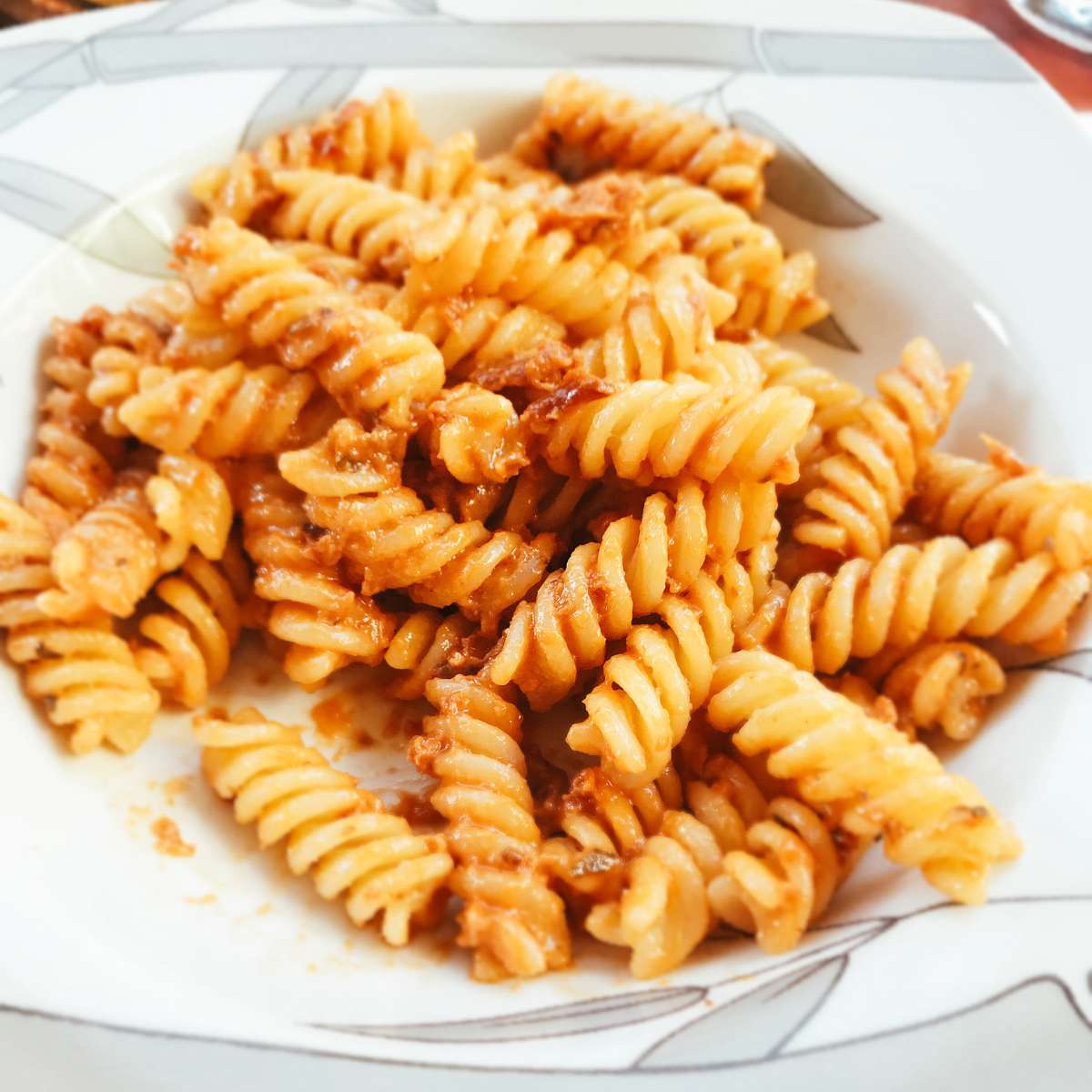
After all, what’s on your plate should not only please your palate but also align with your wellness goals. So, which one slims down your calorie intake and which bulks up on nutrients? It’s time for an egg noodle nutrition comparison to square off against pasta nutritional content.
You may be wondering, “Are egg noodles a heavyweight in terms of fat?” Indeed, these eggy strands pack a little extra punch in the fat department compared to the average pasta.
But hold on—before you sideline them from your diet, it’s worth noting this slight increase in fat means a modest boost in protein, making for a satisfying addition that could benefit your muscles more than your waistline. On the flip side, pasta tends to offer a leaner option, which might be the golden ticket for those counting calories.
Now, it’s not just about the egg noodle vs pasta calories game. Carbohydrates are the main event here, providing you the energy to conquer your day. Both contenders serve up a sizeable portion of carbs, keeping you in the ring from breakfast to dinner.
- If you aim for lower-fat recipes, pasta could be your firm favorite in the ring.
- If your mission includes more protein, egg noodles might be your go-to champion.
Just remember, the trick to winning this nutritional bout is balance. So, whether it’s twirling a forkful of spaghetti or scooping a comforting heap of egg noodles, keeping portions in check ensures you savor the victory without going over your nutritional budget.
Egg Noodle vs Pasta: Evaluating Health Benefits
When staring down the aisles of comfortable, carb-laden treasures in your local supermarket, you might ponder the nutritional punch these foods pack. Yes, you’re onto something here.
There’s more to egg noodles and pasta than meets the eye—or tickles the taste buds, for that matter. Let’s untangle the stringy facts about their health benefits. Are you ready to dive into the bowl and discover what perks lie beneath the surface?
The Impact of Egg Noodles on Your Health
Gleaming with a golden hue, egg noodles aren’t just about pleasing your palates. They’re like the secret agents of your meals, equipped with selenium, an ally in your immune system’s covert operations against nefarious health threats.

Sure, they carry a touch more fat around their midsection, but who doesn’t? Moderation is key, and these noodles delight in playing a tasty role on your plate without crossing the line into indulgence territory.
Whole Grain Pasta: A Healthier Twist?
Now, twirl your fork towards whole grain pasta. It’s like the health-conscious cousin at the family dinner, swapping out stories of extra fiber and nutrients instead of naughty anecdotes.
These whole grain strands are an undercover hero for your cholesterol levels and a friend to your digestive adventures. It’s a charming choice for those on a quest for both taste and pasta health benefits.
| Nutrient | Egg Noodles | Whole Grain Pasta |
|---|---|---|
| Selenium | Good Source | Varies by brand |
| Fiber | Lower levels | Higher levels |
| Protein | Slightly higher | Varies by type |
| Fat Content | Marginally higher | Lower in whole grain varieties |
As you dash a sprinkle of parsley over your culinary creation, violin strings echoing with the promise of a good meal—pause. Your choice between egg noodles and whole grain pasta isn’t just about taste, but a forkful of informed decisions towards health too.
Whether you’re chasing down egg noodle health benefits or entranced by the whole grain pasta benefits, you’re in the driver’s seat, my friend. Bon appétit and to your health!
Culinary Versatility: Which is More Adaptable?
If you’ve ever wondered about the interplay between egg noodle recipes and creative pasta dishes in the kitchen, wonder no more. You’re about to unleash the full potential of egg noodle vs pasta versatility to keep your dinner guests clamoring for seconds.
Exploring Egg Noodle Recipes
It’s time to roll up your sleeves and explore the comforting realm of egg noodle recipes. Let’s face it, nothing yells ‘home-cooked meal’ louder than a plate of egg noodles swirled in a creamy sauce or peppered with tender pieces of chicken.
But here’s the secret: it’s not just about comfort. With egg noodles, you’ve got a foodie playground waiting to be explored, and your culinary imagination is the limit.
Creative Pasta Dishes to Try
Flip the script and pasta’s versatility comes into the spotlight. Whether you’re gunning for a classic spaghetti Bolognese or leaning towards a quirky, artichoke-infused penne, pasta has got your back. And while you’re at it, why not push the boat out with some off-the-wall fusion? Because when it comes to pasta, if you can dream it, you can make it happen.
So, what’s it going to be tonight—slurping up some luscious egg noodles or twirling your fork into a spiraling world of pasta possibilities? Remember, whether you choose to delve into cherished egg noodle recipes or embrace the wild side with creative pasta dishes, you’re the maestro of your kitchen orchestra. Make that symphony sing!
| Egg Noodle Delights | Pasta Masterpieces |
|---|---|
| Classic Beef Stroganoff | Traditional Spaghetti Carbonara |
| Homestyle Chicken Noodle Soup | Seafood Linguine with White Wine Sauce |
| Asian-Inspired Cold Noodle Salad | Roasted Vegetable Lasagna |
| Savory Mushroom Paprikash | Creamy Butternut Squash Penne |
In the final fick of the fork, both egg noodles and pasta offer a canvas for your culinary expression. Pop on that chef’s hat and let the cook-off begin!
Best Egg Noodle and Pasta Substitutes for Your Recipes
Have you ever been ready to whip up your favorite carbonara or a cozy chicken noodle soup, only to find your pantry devoid of pasta or egg noodles? Fear not, culinary adventurer! The food world is rich with substitutes for egg noodles and pasta substitutes that can save your dish—and maybe even make it more exciting.
Enter the game-changing world of vegetable noodles – zucchini spirals, affectionately dubbed ‘zoodles’, and spaghetti squash lay the groundwork for a nutritious twist on traditional noodle and pasta dishes. Loaded with vitamins and boasting high fiber, these veggie-noodled concoctions are sure to impress your tastebuds and your body.
If gluten has given you grief, look to the oceans and fields for solace with kelp noodles and soba. These egg noodle vs pasta alternatives not only sidestep gluten but also bring a symphony of new flavors and textures to your table.
Kelp noodles, with their slight sea-tang, punch up an Asian-inspired salad, while soba’s nuttiness can turn a simple bowl of broth into a memorable meal. They’re the unsung heroes that deserve an ovation in your next dinnertime opera.
And, if you’re one to flex your culinary muscles, it’s time to embrace the chameleon-like quinoa and the mighty lentil in pasta forms, lending both protein and charisma to what could have been an ordinary meal.
Whether it’s swapping in fettuccine with shredded carrots for a crunchy, colorful treat, or opting for linguine’s legume-laden counterparts, your journey through the art of substitution shall lead to a revelation in flavor. So go ahead, experiment with confidence, because your quest for variety just got a delicious upgrade with all these pasta alternatives at your disposal.
FAQ
What are the key differences between an egg noodle and pasta?
The main difference lies in the ingredients and texture—egg noodles are made with a higher proportion of eggs to flour, which yields a richer flavor and a tender, springy texture. Pasta, while it can contain eggs, often relies on a simpler mix of semolina flour and water, leading to a wide range of textures from smooth to firm when cooked al dente. This also impacts the nutritional content, with egg noodles typically having slightly more fat and protein.
Can you give a rundown of the origins of egg noodles?
Absolutely! The beginnings of egg noodles are traced to ancient China, potentially from as far back as 25 to 200 AD. Their history is rich with tradition, spanning various cultures from Eastern European to Asian, and their continuous presence in culinary traditions speaks to their timeless appeal and adaptability.
What about pasta’s debatable beginnings?
Pasta’s origins are a hot topic with several theories in place. Claims range from ancient Greece to Arabia, with evidence pointing to its establishment as a staple in many early civilizations. Regardless of its true origins, pasta has certainly cemented its place as a culinary mainstay across the globe.
What ingredients are commonly used in egg noodles and pasta?
Egg noodles must contain eggs and typically use wheat flour, which may be blended with other starches to achieve the desired texture. Pasta requires wheat or buckwheat semolina flour and water, and may optionally include eggs, which subtly change its flavor and nutritional profile, offering versatility in health benefits, such as being incorporated into lower-fat dishes.
How do the textures of egg noodles and pasta compare?
Egg noodles have a signature silky, tender texture due to the egg content, while pasta’s texture can vary widely from silky smooth to the coveted al dente chew, depending on the pasta type and cooking time.
Are there different types of egg noodles versus types of pasta?
Yes, egg noodles often appear as broad, flat strips and are used in a variety of cultural dishes. Pasta, however, boasts a wide selection of shapes and sizes, each designed for different sauces and cooking styles. The shapes can affect how sauces cling and contribute to the dish’s texture and overall experience.
Do egg noodles and pasta have different flavors?
Indeed they do. Egg noodles have a distinct, rich taste from the egg content, lending itself well to hearty, comforting meals. Pasta tends to have a more subtle flavor, allowing it to absorb and complement a wide range of sauces and ingredients, from garlic and oil to meaty Bolognese.
How does the nutritional content of egg noodles stack up against pasta?
Both egg noodles and pasta are comparable in calories and carbohydrates, but egg noodles have slightly more protein, fat, and cholesterol due to the eggs. This also means they can provide a bit more of an energy and protein boost compared to regular pasta.
What are the health benefits of including egg noodles in your diet?
Egg noodles are a good source of protein and also provide selenium, which is key for a healthy immune system. They can add nutritional value to your meals, especially if they are whole grain or enriched with additional nutrients.
Is whole grain pasta a healthier option?
Whole grain pasta can be a healthier option as it provides more fiber and nutrients compared to traditional white pasta. This fiber is valuable for maintaining good digestive health and can help with maintaining healthy cholesterol levels.
Which is more adaptable in the kitchen, egg noodles or pasta?
Both are quite adaptable, but pasta may have the edge due to its countless variations. Egg noodles are essential in certain classic dishes, while pasta’s variety in shape and neutrality in taste allow for endless creative culinary explorations.
Are there any good substitutes for traditional egg noodles or pasta in recipes?
For sure! Veggie substitutes like zucchini noodles and spaghetti squash are great for a nutrient boost and lower carbs. Gluten-free options like kelp noodles and soba offer unique textures, and grains like quinoa or lentil pasta add a protein-packed alternative. The possibilities are as broad as your culinary curiosity.
